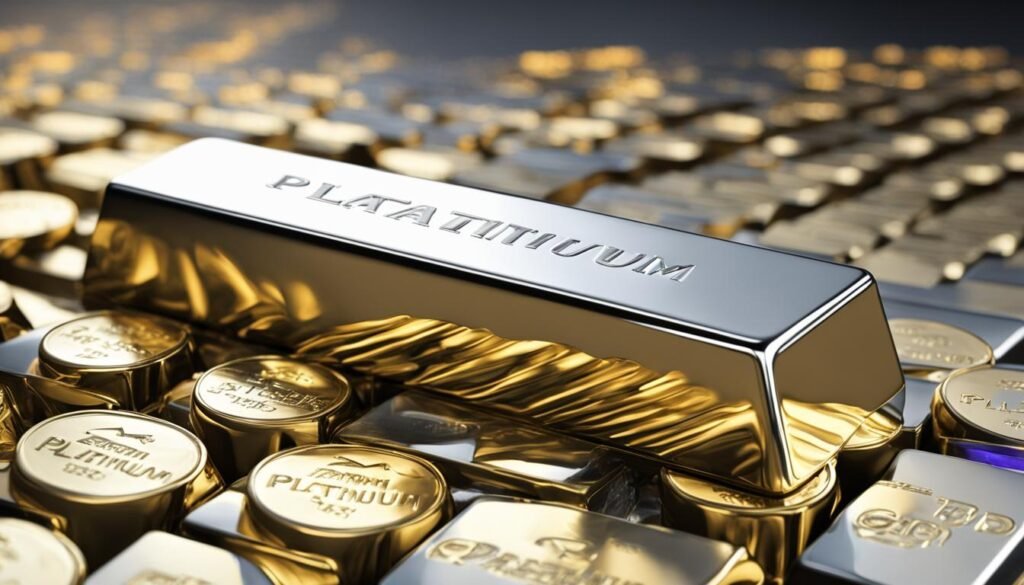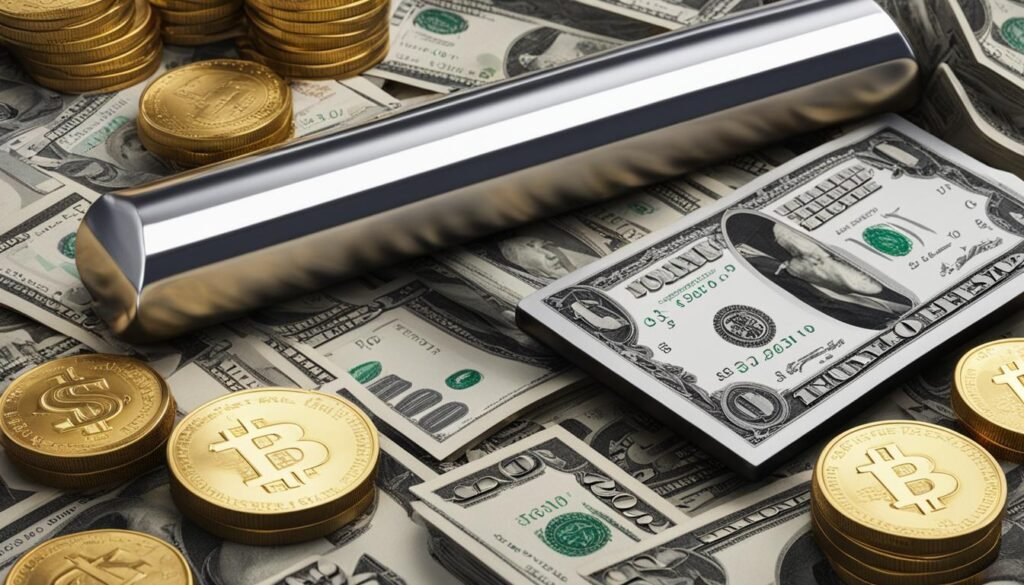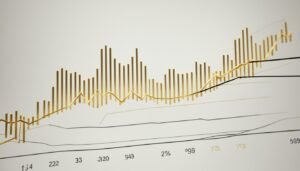Why is Platinum Cheaper than Gold?
Platinum is known to be cheaper than gold, but the reasons for this price difference can be intriguing. Understanding the factors that contribute to the lower cost of platinum compared to gold involves examining precious metal valuation and market dynamics. Let’s delve into the fascinating world of platinum and gold prices.
Key Takeaways
- Precious metal valuation and market dynamics play a crucial role in the price difference between platinum and gold.
- The relative scarcity and demand for platinum and gold influence their respective prices.
- The supply of platinum is limited, contributing to its higher value compared to other precious metals.
- Platinum’s demand is driven by its unique properties, especially in the automotive industry.
- Market perception, economic factors, and market volatility also impact platinum and gold prices.
The Valuation of Platinum and Gold
Understanding the valuation of platinum and gold is key to unraveling the mystery of why platinum is cheaper than gold. Precious metals, such as platinum and gold, are valued based on a combination of factors, including supply and demand dynamics.
Both platinum and gold have inherent value due to their scarcity and unique properties. However, platinum is rarer than gold, which makes it more precious in terms of supply. The limited sources of platinum extraction worldwide contribute to its higher value compared to gold.
Precious Metal Valuation Factors
Several factors affect the valuation of platinum and gold:
- Supply and demand dynamics
- Rarity and availability
- Industrial and investment demand
- Market sentiment and perception
Supply and demand dynamics play a significant role in determining the prices of both platinum and gold. The balance between the availability of these metals and the demand for them in various industries and investment markets affects their respective valuations.
Platinum’s unique physical and chemical properties make it essential in numerous industrial applications, such as automotive catalysts and jewelry. The demand for platinum in these sectors creates a strong market presence but still falls short compared to gold’s historical significance as a traditional store of value.
| Factors | Valuation Influence |
|---|---|
| Supply and demand dynamics | Determines the balance between availability and demand, impacting prices |
| Rarity and availability | Platinum’s limited sources of extraction contribute to higher value compared to gold |
| Industrial and investment demand | Platinum’s industrial applications create significant demand, but gold’s historical value as a store of wealth remains influential |
| Market sentiment and perception | Psychological factors associated with platinum and gold impact their demand and prices |
Overall, the valuation of platinum and gold is a complex interplay of factors influenced by supply and demand, rarity, industrial applications, market sentiment, and perception. Understanding these dynamics can shed light on why platinum is cheaper than gold and provide insights into the intriguing world of precious metal valuation.
Platinum and Gold Supply
When it comes to understanding why platinum is cheaper than gold, one key factor to consider is the supply of these precious metals. Platinum is rarer than gold, with limited sources of extraction worldwide. Its scarcity contributes to its higher value compared to other precious metals. On the other hand, gold has a more extensive supply and is more readily available in various regions around the world.
To put this into perspective, according to recent data from the World Platinum Investment Council, global platinum production reached approximately 6 million ounces in 2020. In contrast, gold production was significantly higher, reaching around 111 million ounces in the same year. This stark contrast in production levels highlights the scarcity of platinum in comparison to gold.
Furthermore, platinum mining is a complex process that involves several challenges. The mining industry faces obstacles such as the depth at which platinum deposits are found, which requires advanced and costly extraction methods. In contrast, gold mining is relatively simpler and less expensive, allowing for higher production volumes.
The Mining Industry and its Impact
The mining industry plays a crucial role in determining the supply of platinum and gold. Mining companies invest in exploration and extraction activities, seeking profitable reserves of these metals. However, due to the challenges and costs associated with platinum mining, the supply remains limited.
Another crucial point to consider is that platinum deposits are often co-mined with other metals, such as palladium and rhodium. These metals, known as platinum group metals (PGMs), have their own unique demand and supply dynamics. As a result, the extraction and production of platinum are influenced by factors beyond platinum alone.
The Impact on Prices
The limited supply of platinum compared to gold has a significant impact on the pricing dynamics of these precious metals. The scarcity of platinum makes it more valuable, as demand outpaces supply. On the other hand, gold’s abundant supply allows for lower prices in comparison. Consequently, these supply dynamics contribute to platinum’s lower price point relative to gold.
| Platinum | Gold | |
|---|---|---|
| Supply | Limited | Abundant |
| Production (2020) | Approximately 6 million ounces | Approximately 111 million ounces |
| Mining Complexity | Challenging and costly | Relatively simpler and less expensive |
Platinum and Gold Demand in Industrial Applications
The demand for platinum and gold extends beyond their value as precious metals. Both metals play crucial roles in various industrial applications, contributing to their overall demand and influencing their prices. Understanding the industrial demand factors can shed light on why platinum is cheaper than gold.
Platinum Industrial Applications
Platinum’s unique physical and chemical properties make it highly sought after in several industries. One of the primary applications of platinum is in the automotive sector, where it is used in catalytic converters to reduce harmful emissions. The stricter environmental regulations around the world have increased the demand for platinum in this industry.
Furthermore, platinum is extensively used in the chemical industry for producing various catalysts, including those used in the production of fertilizers and pharmaceuticals. Its exceptional resistance to corrosion and high-temperature stability make it a valuable component in manufacturing processes that require these properties.
Additionally, platinum is utilized in the electrical industry for producing electrodes, contacts, and thermocouples due to its excellent electrical conductivity and reliability. Its use in the glass industry for making optical fibers and in the petroleum industry for refining processes further adds to its industrial demand.

Gold Industrial Applications
While gold is traditionally associated with jewelry and investment, it also has significant industrial applications. In the electronics industry, gold’s excellent conductivity and resistance to corrosion make it an ideal material for manufacturing circuit boards, connectors, and contacts.
Moreover, gold is widely used in the medical and dental fields, where its biocompatibility and aesthetic appeal make it an essential component in dental alloys, implants, and medical devices. Its reflective properties also make it valuable in the aerospace industry for coating satellites and spacecraft.
Furthermore, gold finds applications in the chemical industry for fabricating catalysts and in the telecommunications industry for producing high-quality fiber optics. The versatility of gold across different industries contributes to its demand alongside its traditional role as a store of value.
Understanding the industrial applications that drive the demand for platinum and gold provides valuable insights into their pricing dynamics. While both metals have their unique qualities and uses, the variations in demand across different industries contribute to the price difference between platinum and gold.
Industrial Applications of Platinum and Gold
Platinum and gold have distinct industrial applications that contribute to their varying prices. Platinum, known for its exceptional physical and chemical properties, finds extensive use in the automotive industry. Its remarkable catalytic properties make it an essential component of catalytic converters, reducing harmful emissions from vehicles. The automotive sector’s demand for platinum remains robust, driving its price in the market.
On the other hand, gold plays a prominent role in industries such as electronics and jewelry. Its excellent electrical conductivity and resistance to corrosion make it ideal for electronic components like connectors and circuit boards. Additionally, gold’s lustrous appearance and scarcity have made it a prized metal for creating exquisite jewelry pieces. The demand for gold in these sectors contributes to its comparatively higher price compared to platinum.
In summary, platinum and gold have diverse industrial applications that influence their respective prices. Platinum’s significance in the automotive sector and gold’s usage in electronics and jewelry contribute to the discrepancy in their values. By understanding these applications, we gain insight into why platinum is cheaper than gold.
Market Perception and Sentiment
When it comes to the prices of platinum and gold, market perception and investor sentiment play a significant role. These psychological factors can impact the demand for and subsequently influence the prices of these precious metals. Understanding the dynamics of market perception and investor sentiment is crucial in unraveling the mystery of why platinum is cheaper than gold.
Investors often form opinions and sentiments based on various factors such as economic indicators, geopolitical events, and market trends. These sentiments can drive their decisions to buy or sell precious metals, thereby influencing the overall demand and prices. Market perception, on the other hand, refers to how the broader market views the value and potential of platinum and gold.
The perception that gold is a traditional safe haven asset with a long-standing reputation as a store of value may contribute to its relatively higher price compared to platinum. Investors seeking stability and security during uncertain times often turn to gold, driving up its demand. Platinum, while also considered a valuable precious metal, may not receive the same level of perceived value as gold from investors.
“Investor sentiment can be influenced by a range of factors, from economic indicators to geopolitical tensions. These sentiments shape the demand for precious metals, including platinum and gold, and subsequently impact their prices.” – Market Analyst
It is essential to note that market perception and investor sentiment can be swayed by short-term trends and speculative activity. Sudden shifts in market sentiment, driven by factors like news events or market speculation, can create volatility in both platinum and gold prices. Therefore, understanding these psychological factors is crucial in analyzing the price discrepancy between platinum and gold.

Overall, market perception and investor sentiment have a significant impact on the prices of platinum and gold. These psychological factors, along with other market dynamics, highlight the complexity of the precious metals market. By delving into market perception and investor sentiment, we can gain valuable insights into why platinum may be cheaper than gold.
Economic Factors
Economic factors play a crucial role in determining the prices of precious metals like platinum and gold. The global financial stability and market fluctuations have a significant impact on the valuation of these metals. The interplay between economic conditions and investor sentiment creates an environment where the prices of platinum and gold can fluctuate.
The global financial stability is a key determinant of the prices of platinum and gold. When the economy is stable, investor confidence is high, leading to increased demand for both metals. On the other hand, during periods of economic uncertainty, such as recessions or financial crises, investors may seek the safety of gold as a store of value, driving up its price. Understanding the economic landscape and its effect on the demand and supply of platinum and gold is essential in comprehending why platinum is cheaper than gold.
Market fluctuations also play a significant role in shaping the prices of platinum and gold. Factors like interest rates, inflation rates, and currency movements can impact the demand and supply dynamics of these metals. For example, a stronger dollar can make gold relatively more expensive for international buyers, thereby affecting its price. Similarly, changes in interest rates can influence investor preferences for platinum or gold as an investment asset. Monitoring these economic factors provides valuable insights into the price differences between platinum and gold.
| Economic Factors | Impact on Platinum and Gold Prices |
|---|---|
| Global financial stability | Influence investor sentiment and demand for precious metals |
| Market fluctuations | Affect the supply and demand dynamics of platinum and gold |
As we explore the reasons behind the price difference between platinum and gold, it becomes clear that economic factors play a pivotal role. The interplay between global financial stability, market fluctuations, and investor sentiment creates an intricate web of influences on the prices of these precious metals.

Conclusion
Investing in platinum and gold can offer a range of benefits for your investment portfolio. Whether you choose platinum for its unique industrial applications or gold for its historical store of value, adding these precious metals can provide diversification and potentially enhance your portfolio’s performance. However, it is essential to carefully assess your investment goals, risk tolerance, and market conditions before making any investment decisions. By understanding the differences between platinum and gold and conducting thorough research, you can make informed investment choices and maximize the potential benefits of including precious metals in your portfolio.
Price Manipulation and Market Forces
When examining the price difference between platinum and gold, it is essential to consider the role of price manipulation and market forces. These factors can significantly impact the prices of these precious metals, creating disparities that may seem puzzling at first glance.
Price manipulation occurs when market participants, such as investors and institutions, attempt to influence the supply and demand dynamics of platinum and gold. Their actions can create artificial fluctuations in prices, leading to fluctuations that may not align with the true value of these metals.
Market forces, on the other hand, encompass the overall supply and demand dynamics in the precious metals market. Global economic conditions, geopolitical events, and investor sentiment all play a role in shaping these market forces. Understanding the interplay between price manipulation and market forces can provide valuable insights into why platinum might be cheaper than gold.
| Platinum | Gold | |
|---|---|---|
| Supply | Limited sources of extraction worldwide | Relatively abundant |
| Demand | Driven by industrial applications | Traditional store of value |
| Market Perception | Perceived as lesser in value compared to gold | Long-standing reputation as a valuable asset |
| Investment Demand | Less favored by investors compared to gold | Considered a safe haven investment |
“Understanding the interplay between price manipulation and market forces can provide valuable insights into why platinum might be cheaper than gold.”
As depicted in the table above, various factors contribute to the price difference between platinum and gold. While platinum has limited sources of extraction and is primarily driven by industrial demand, gold’s abundance and traditional store of value perception make it a sought-after asset for investors. Additionally, market perception and investment demand can also influence the relative prices of these metals.
The Role of Platinum Group Metals
Platinum is one of the three main metals in the platinum group metals (PGMs) category, alongside palladium and rhodium. These metals share similar chemical properties and are commonly used in various industrial applications. Understanding the dynamics of the PGM market is crucial to comprehending why platinum is cheaper than gold.
Palladium, another metal in the PGM group, has gained significant attention in recent years due to its critical role in catalytic converters for vehicles. With the increasing global focus on reducing emissions, the demand for palladium has surged, resulting in higher prices. Rhodium, on the other hand, is known for its exceptional catalytic properties and finds applications in the automotive, chemical, and glass industries.
While platinum has its own unique industrial applications, such as in the production of jewelry, chemical catalysts, and electrical components, it faces competition from palladium and rhodium. The varying levels of demand for these metals based on their respective applications contribute to the overall price dynamics of the PGM market.
Table: Comparison of Platinum, Palladium, and Rhodium
| Platinum | Palladium | Rhodium | |
|---|---|---|---|
| Primary Applications | Jewelry, Chemical Catalysts, Electrical Components | Catalytic Converters, Electronics | Catalytic Converters, Chemical Catalysts, Glass Industry |
| Global Production | Approximately 130 metric tons | Approximately 210 metric tons | Approximately 30 metric tons |
| Market Price (per ounce) | $1,000-$1,200 | $2,000-$3,000 | $15,000-$30,000 |
| Industrial Demand | Stable | Increasing (Catalytic Converters, Electronics) | Varies (Catalytic Converters, Chemical Catalysts, Glass Industry) |
As the table illustrates, palladium and rhodium have higher market prices compared to platinum due to their increased demand in key industries. This disparity, along with the varying global production levels, contributes to platinum’s lower price relative to gold.
“The platinum group metals, including platinum, palladium, and rhodium, play significant roles in various industrial sectors. Understanding the unique demand and supply dynamics of these metals is essential to grasp why platinum is cheaper than gold.” – Industry Expert
Overall, the platinum group metals market is complex, with each metal having distinct characteristics and applications. The interplay between industrial demand, global production levels, and market prices of platinum, palladium, and rhodium all influence the price discrepancy between platinum and gold. Analyzing the role of platinum group metals provides valuable insights into the factors influencing the precious metal market.

Conclusion
In conclusion, the price difference between platinum and gold can be attributed to a combination of factors. Valuation plays a significant role, with the relative scarcity and demand for each metal influencing their market prices. Platinum’s limited sources of extraction contribute to its higher value compared to gold.
Furthermore, the industrial applications of platinum and gold also contribute to the price discrepancy. Platinum is widely used in the automotive industry for catalytic converters, while gold finds its primary applications in electronics and jewelry. These variations in industrial demand impact the prices of these precious metals.
Investment considerations, such as portfolio diversification and risk assessment, also influence the prices of platinum and gold. Investors often include these metals in their portfolios, and market perception and sentiment can affect their demand and subsequent prices.
Overall, unraveling the mystery of why platinum is cheaper than gold requires examining a range of factors, including valuation, supply and demand dynamics, industrial applications, and investment considerations. By understanding these factors, we gain valuable insights into the platinum versus gold debate and the fascinating world of precious metal prices.
FAQ about Why is Platinum Cheaper than Gold
Why is platinum cheaper than gold?
The price difference between platinum and gold can be attributed to a combination of factors, including supply and demand dynamics, industrial applications, market perception, economic factors, market volatility, and investment considerations.
How are platinum and gold valued?
The valuation of platinum and gold is influenced by factors such as their relative scarcity, supply and demand dynamics, and market forces. These factors contribute to determining the prices of these precious metals.
What factors affect the supply of platinum and gold?
The supply of platinum and gold is primarily dependent on the mining industry. Platinum is rarer than gold, with limited sources of extraction worldwide. The scarcity of platinum contributes to its higher value compared to other precious metals.
What drives the demand for platinum and gold?
While gold has a long-standing reputation as a traditional store of value, platinum’s demand is driven by its unique physical and chemical properties, making it essential in various industrial sectors. The demand for these metals is influenced by their respective industrial applications.
What are the industrial applications of platinum and gold?
Platinum finds extensive use in the automotive industry for catalytic converters, while gold is primarily employed in the electronics and jewelry sectors. The variations in industrial applications can contribute to the discrepancy in the prices of platinum and gold.
How do market perception and investor sentiment impact platinum and gold prices?
The psychological factors associated with platinum and gold can influence their demand and subsequently impact their prices. Market perception and investor sentiment play a role in determining the prices of these precious metals.
What economic factors affect the prices of platinum and gold?
Global financial stability and market fluctuations are economic factors that can influence the prices of precious metals like platinum and gold. The economic landscape and its impact on the value of these metals contribute to their price differences.
Why do platinum and gold prices experience volatility and fluctuations?
Factors such as geopolitical events, economic indicators, and investor behavior can contribute to the volatility in platinum and gold prices. The precious metals market is known for its frequent price fluctuations.
How does consumer demand and preferences impact platinum and gold prices?
The market for platinum and gold jewelry differs based on consumer preferences and cultural influences. Consumer demand and preferences for platinum and gold jewelry can impact their respective prices.
How do investment considerations affect platinum and gold prices?
Investors often include precious metals like platinum and gold in their portfolios as part of diversification strategies. The considerations for investing in platinum and gold, including risk assessment and potential returns, can influence their prices.
What role does price manipulation and market forces play in platinum and gold prices?
The actions of market participants, such as investors and institutions, can influence the supply and demand dynamics of platinum and gold, leading to price disparities. Price manipulation and market forces are factors that can impact the prices of these precious metals.
What are platinum group metals?
Platinum belongs to the family of platinum group metals (PGMs), which includes palladium and rhodium. The demand for these metals varies based on their respective industrial applications, contributing to the broader context of understanding why platinum is cheaper than gold.
What challenges and future trends impact the prices of platinum and gold?
Factors such as mining operations, technological advancements, and environmental concerns shape the landscape of the platinum and gold industries. These challenges and future trends can impact the prices of these precious metals.
How does investment demand affect platinum and gold prices?
Investment demand, including speculative activity, can influence the prices of platinum and gold. The preferences of investors, market trends, and macroeconomic factors all contribute to the investment demand for these metals.
Why is platinum cheaper than gold?
Unraveling the mystery of why platinum is cheaper than gold involves considering a range of factors, including valuation, supply and demand, market dynamics, industrial applications, and investment considerations. The combination of these factors contributes to the price difference between platinum and gold.








